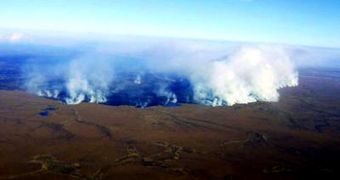Scientists have determined that, as global warming causes average Arctic temperatures to increase, tundras have higher chances of suffering devastating fires, such as the September 2007 Anaktuvuk River Fire.
The natural disaster, which took place in Alaska's North Slope, affected more than 1,000 square kilometers of tundra, almost twice as much as any previous fires did since records began being kept, in 1950.
Subsequent digs and sample analysis in the area revealed that the 2007 devastation was the largest to take place in the region in the last 5,000 years. Sediment cores keep clues as to how fires affected this portion of tundra over past millennia.
Using some 60 years of climate and fire data, researchers were able to construct computer models to simulate the changes the tundra is currently going through.
The research revealed that even minimal temperature rises during the warm season in the Arctic can cause a significantly higher risk of wildfires in the tundra. The study appears in the October issue of the top scientific Journal of Geophysical Research.
“If such fires occur every 200 years or every 500 years, it's a natural event. But another possibility is that these are truly unprecedented events caused by, say, greenhouse warming,” says Feng Sheng Hu.
The researcher is a plant biology professor at the University of Illinois in Urbana-Champaign (UIUC). He and his team investigated the North Slope in 2008, in a bid to make sense of what the tundra fire was all about.
During the study, he and his team flew to the place of the 2007 fire, and collected sediment cores from two lakes that had been affected by the disaster. The distribution of charcoal particles was one of the most important aspects that were analyzed.
Using cores spanning more than 5,000 years back in history, the researchers found no traces of a fire of similar intensity in the area's recent history.
The team then created an association model that used these data and records of temperatures and precipitations in the area stretching back six decades. Hu says that a pattern of correlations immediately became visible.
“There is a dramatic, nonlinear relationship between climate conditions and tundra fires, and what one may call a tipping point,” the team leader says.
“The tundra is just going to burn more frequently” when the June-through-September time period rises above a mean threshold of 10 degrees Celsius, Hu adds.
“As temperature rises, so too does evaporation. So even if future precipitation increases, it's likely that increased evaporation will result in overall lower moisture availability,” the expert says.
“This affects plants, but it also makes dead vegetation more flammable and fire prone,” he adds. Funding for the investigation came from the US National Science Foundation (NSF) and the Joint Fire Science Program.

 14 DAY TRIAL //
14 DAY TRIAL //